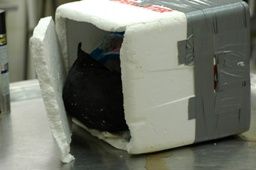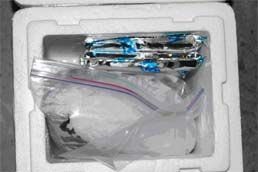Dealing with death losses on the ranch can be disheartening. After all, a beef cattle operation’s success is measured in pounds of live weight sold. Every beef cattle producer knows that this is part of ranching. However, sometimes death losses cannot be explained, leaving ranchers with more questions than answers. Good observation, a working relationship with a veterinarian (also known as the veterinarian-client-patient relationship [VCPR]), the local Farm Service Agency (FSA), and preparation can help livestock owners rule out possibilities and, in some cases, possibly recoup a portion of losses.
Scouting
Observing the cattle herd, recognizing normal behavior and abnormal behavior, and surveying pastures for noxious weeds, predators, and other sources of injury to the herd are important.
Calving season is a particularly vulnerable time of year. Livestock owners should periodically check on their herd to ensure calves are hitting the ground without complications. Discovering an aborted fetus or a dead calf, with or without a dead cow, is a reason for concern. A good working relationship with a local large animal veterinarian can help to determine death losses. Animal losses warrant a call to the veterinarian.
Bronson Animal Disease Diagnostic Laboratory (BADDL)
The Florida Department of Agriculture and Consumer Services Division of Animal Industry’s Bronson Animal Disease Diagnostic Laboratory (BADDL) located in Kissimmee, Florida is a useful and important service available to livestock owners and veterinarians alike. The lab offers diagnostic services to potentially identify the cause of death, among other valuable services to Florida’s livestock industry. BADDL is the only accredited laboratory in Florida to test foreign animal diseases. It is also a member of the National Animal Health Laboratory Network (NAHLN).
Various tests can be used to try and determine the cause of death, but these individual tests can be very expensive. The best option when experiencing death losses is to request a necropsy examination from a trained pathologist. The gross necropsy exam is a systematic, external and internal, gross examination (i.e., visually unassisted) of the deceased animal with the aim of obtaining as much information as possible to help to determine the cause of death and/or clinical disease. A necropsy examination also includes a histopathological exam (the examination of tissue sections from the animal using a light microscope in order to look for abnormal changes and/or lesions). The BADDL offers three different necropsy examination services: the Food and Fiber Animal Necropsy Exam at $100/animal; the Forensics, Research, and Insurance Exam at $250/animal; or the Necropsy in a Bottle (microscopic examination only) at $75/animal. The Food and Fiber Animal Necropsy Exam is the most typical and cost-saving option for beef cattle operations. It includes the gross necropsy exam, the histopathological exam, and all in-house bacteriological, parasitological, molecular, virologic, and serological testing. Additional testing to address concerns such as toxicity or mineral deficiencies can be done through other accredited labs with client approval and consensus of financial responsibility, due to additional costs for these analyses. The BADDL offers this service at a price well below the cost of the actual testing procedures. A veterinarian will be able to help livestock producers decide which test is best for their situation. Submitting a whole carcass is an economical way to get comprehensive health information about the herd.
Submitting Tissue or Carcasses for Examination
Submitting an adult carcass to the lab can be a logistical challenge but is recommended for a thorough examination by a pathologist. When submitting a whole carcass is not possible, a field necropsy may be performed by a submitting veterinarian (the client veterinarian performing the necropsy of the dead animal who can collect samples to submit to the diagnostic laboratory). In this case, submitting tissue (organs, fluids, etc.) may be an option. Consulting with a veterinarian and the BADDL may help to determine which tissue should be submitted. Fetuses and calf carcasses can be more easily submitted in their entirety.
Tissue or carcasses may be hand-delivered to the laboratory in Kissimmee. Call the lab at (321) 697-1400 in advance to ensure their ability to receive.
Alternatively, tissue or smaller carcasses (typically 50 lb or less) can be shipped. Contact the BADDL prior to shipping to confirm acceptance.
To ship tissue samples, it is recommended that a veterinarian and the BADDL be contacted to determine which tissues (organs, fluids, etc.) must be submitted and how they should be prepared and shipped.
For carcasses, it is preferred that the animal be submitted chilled instead of frozen. However, the carcass should be frozen prior to shipment if the interval between the animal's death and receipt at the laboratory will be more than three days. The carcass submitted must be fresh (i.e., preferably received within 24 hours after death, with no preservatives such as alcohol or formalin applied), because the rapid degradation of the tissues after death hinders evaluation. The carcass must be placed inside a sealed bag to prevent leaking, with enough ice packs and absorbent material. The carcass and ice packs should be placed inside a Styrofoam box and then placed in an external cardboard box. Packages must be shipped overnight.
Packaging must meet all of the following conditions:
- A leakproof primary receptacle.
- Leakproof secondary packaging.
- An outer packaging of adequate strength for its capacity, mass, and intended use.
For liquids (ice and body fluids), absorbent material that can absorb all of the container’s contents must be placed between the primary receptacle and the secondary packaging so that, during transport, any release or leak of a liquid substance will not reach the outer packaging and will not compromise the integrity of the cushioning material.
Refer to the figures below for examples of improperly packed samples (Figures 1 and 2) and a properly packed sample (Figure 3).

Credit: FDACS/BADDL

Credit: FDACS/BADDL

Credit: FDACS/BADDL
Examination results are typically returned within 20 business days, depending on the need for additional testing. For more information about the Bronson Animal Disease Diagnostic Laboratory, submission forms, and contact information, visit their website at www.FDACS.gov/BADDL.
Livestock Indemnity Program (LIP)
In rare instances, losses are caused by adverse weather conditions or predation by certain predators. The United States Department of Agriculture Farm Service Agency (FSA) administers the Livestock Indemnity Program (LIP). The Agriculture Improvement Act of 2018 (the 2018 Farm Bill) authorized the LIP to provide benefits to eligible livestock producers for livestock deaths in excess of normal mortality caused by eligible loss conditions, including specific disease and attacks by animals reintroduced into the wild by the federal government or protected by federal law. For more information on eligibility, contact your local FSA office (https://www.fsa.usda.gov/index).
Summary and Conclusion
While no livestock producer wants to face death losses on their operation, personal observation and preparation, a working relationship with their veterinarian (current VCPR), the FDACS Bronson Animal Disease Diagnostic Laboratory, and the Farm Service Agency can all help to mitigate these losses.